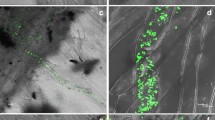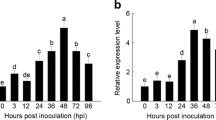Abstract
The potential role of two pathogen-induced pepper genes, encoding basic pathogenesis-related protein 1 (CABPR1) and ascorbate peroxidase-like 1 (CAPOA1), in tolerance against phytopathogens was examined in transgenic tomato (Lycopersicum esculentum cv. House Momotaro) plants. Polymerase chain reaction and reverse transcription-polymerase chain reaction analyses using gene-specific primers revealed that the pepper CABPR1 and CAPOA1 genes were integrated into the tomato genome. The constitutive expression of CABPR1 and CAPOA1 in the tomato did not exhibit any morphological abnormalities. However, these transgenic tomato plants showed enhanced tolerance to the oomycete pathogen Phytophthora capsici, and very weak resistance to the bacterial pathogen Pseudomonas syringae pv. tomato. These results suggest that overexpression of CABPR1 and CAPOA1 in tomato plants altered their resistance responses to pathogenic attack.
Similar content being viewed by others
References
Alexander D, Goodman RM, Gut-Rella M, Glascock C, Weyman K, Friedrich L, Maddox D, Ahl-Goy P, Luntz T, Ward E, Ryals J (1993) Increased tolerance to two oomycete pathogens in transgenic tobacco expressing pathogenesis-related protein 1a Proc. Natl. Acad. Sci. USA 90: 7327–7331
Aono M, Saji H, Sakamoto A, Tanaka K, Kondo N, Tanaka K (1995) Paraquat tolerance of transgenic Nicotiana tabacum with enhanced activities of glutathione reductase and superoxide dismutase Plant Cell Physiol. 36: 1687–1691
Bradley DJ, Kjellbom P, Lamb CJ (1992) Elicitor and wound-induced oxidative cross-linking of a plant cell wall proline-rich protein: a novel, rapid defense response Cell 70: 21–30
Bueno P, Piqueras A (2002) Effect of transition metals on stress, lipid peroxidation and antioxidant enzyme activities in tobacco cell cultures Plant Growth Reg. 36: 161–167
Camp WV, Capiau K, Montagu MV, Inze D, Slooten L (1996) Enhancement of oxidative stress tolerance in transgenic tobacco plants overproducing Fe-superoxide dismutase in chloroplasts Plant Physiol. 112: 1703–1714
Davis DG, Swanson HR (2001) Activity of stress-related enzymes in the perennial weed leafy spurge (Euphorbia esula L.) Env. Exp. Bot. 46: 95–108
Do HM, Hong JK, Jung HW, Kim SH, Ham JH, Hwang BK (2003) Expression of peroxidase like genes, H2O2 production, and peroxidase activity during the hypersensitive response to Xanthomonas campestris pv. vesicatoria in Capsicum annuumMol. Plant-Microbe Int. 16: 196–205
Edwards K, Johnstone C, Thompson C (1991) A simple and rapid method for the preparation of plant genomic DNA for PCR analysis Nucleic Acids Res. 19: 1349
Herbers K, Meuwly P, Frommer WB, Metraux JP, Sonnewald U (1996) Systemic acquired resistance mediated by the ectopic expression of invertase: possible hexose sensing in the secretory pathway Plant Cell 8: 793–803
Hong JK, Hwang BK (2005) Induction of enhanced disease resistance and oxidative stress tolerance by overexpression of pepper basic PR-1 gene in Arabidopsis Physiol. Plant. 124: 267–277
Huckelhoven R, Dechert C, Trujillo M, Kogel KH (2001) Differential expression of putative cell death regulator genes in near-isogenic, resistant and susceptible barley lines during interaction with the powdery mildew fungus Plant Mol. Biol. 47: 739–748
Jespersen HM, Kjaersgard IVH, Ostergaard L, Welinder KG (1997) From sequence analysis of three novel ascorbate peroxidases from Arabidopsis thaliana to structure, function and evolution of seven types of ascorbate peroxidase Biochem. J. 326: 305–310
Kamoun S, Klucher KM, Coffey MD, Tyler BM (1993) A gene encoding a host-specific elicitor protein of Phytophthora parasitica Mol. Plant-Microbe Interact. 8:302–310
Kazan K, Goulter KC, Way HM, Manners JM (1998) Expression of a pathogenesis-related peroxidase of Stylosanthes humilis in transgenic tobacco and canola and its effect on disease development Plant Sci. 136: 207–217
Kim YJ, Hwang BK (2000) Pepper gene encoding a basic pathogenesis-related 1 protein is pathogen and ethylene inducible. Physiol. Plant. 108: 51–60
King EO, Ward NK, Raney DE (1954) Two simple media for the demonstration of pyrocyanin and fluorescein J. Lab. Clinic Med. 44: 301–307
Kvaratskhelia M, George SJ, Thorneley RNF (1997) Salicylic acid is a reducing substrate and not an effective inhibitor of ascorbate peroxidase J. Biol. Chem. 272: 20998–21001
Mader M, Fussl R (1982) Role of peroxidase in lignification of tobacco cells Plant Physiol. 70: 1132–1134
Murashige H, Skoog F (1962) A revised method for rapid growth and bioassays with tobacco tissue cultures Physiol. Plant. 15: 472–497
Park SH, Morris JL, Park JE, Hirschi KD, Smith RH (2003) Efficient and genotype-independent Agrobacterium-mediated tomato transformation J. Plant Physiol. 160: 1253–1257
Sarowar S, Kim EN, Kim YJ, Ok SH, Kim KD, Hwang BK, Shin JS (2005a) Overexpression of a pepper ascorbate peroxidase-like 1 gene in tobacco plants enhances tolerance to oxidative stress and pathogens Plant Sci. 169: 55–63
Sarowar S, Kim YJ, Kim EN, Kim KD, Hwang BK, Islam R, Shin JS (2005b) Overexpression of a pepper basic pathogenesis-related protein 1 gene in tobacco plants enhances resistance to heavy metal and pathogen stresses Plant Cell Rep. 24: 216–224
Sarowar S, Oh HY, Hyung NI, Min BW, Harn CH, Yang SK, Ok SH, Shin JS (2003) In vitro micropropagation of a Cucurbita interspecific hybrid cultivar-a root stock plant Plant Cell Tiss. Org. Cult. 75: 179–182
Way HM, Kazan K, Goulter KC, Birch RG, Manners JM (2000) Expression of the Shpx2 peroxidase gene of Stylosanthes humilis in transgenic tobacco leads to enhanced resistance to Phytophthora parasitica pv. nicotianae and Cercospora nicotianaeMol. Plant Pathol. 1: 223–232
Acknowledgement
This study was supported by the special grant from the Agricultural R&D Promotion Center funded by the Ministry of Agriculture and Forestry.
Author information
Authors and Affiliations
Corresponding author
Rights and permissions
About this article
Cite this article
Sarowar, S., Kim, Y.J., Kim, E.N. et al. Constitutive expression of two pathogenesis-related genes in tomato plants enhanced resistance to oomycete pathogen Phytophthora capsici . Plant Cell Tiss Organ Cult 86, 7–14 (2006). https://doi.org/10.1007/s11240-006-9090-6
Received:
Accepted:
Published:
Issue Date:
DOI: https://doi.org/10.1007/s11240-006-9090-6




